The frontispiece is of the wedding of Julia and Lord Ongar. It is a head-on shot of the bride and groom leaving the church together. Behind them are a number of wedding attendants, about six crowded into the picture. Julia is dressed in a long flowing gown, a necklace, and a headdress that appears to be made of flowers. Over her head she has a veil which flows over her bare shoulders. She is holding a bouquet in her left hand. Her face looks a bit bored. A nearby bridesmaid appears to have a similar costume without the bouquet. Lord Ongar does not look like a man on his deathbed, as I was given to understand. His age could be anywhere in his forties or fifties; his hair seems to have some gray in it. He is dressed in a long frock coat and is carrying a tall silk hat. He is looking at Julia with an appreciative glance. The caption, however, tells it all: "a puir feckless thing, tottering along like--." The caption comes from the quote out of the mouth of an old farmer's wife at the end of Chapter Three. The rest of the quote is "not half the makings of a man. A stout lass like she could a'most blow him away wi' a puff of her mouth."
David Christie wrote about a later illustration of the same moment: The illustrations to the Folio Society edition of The Claverings 1994, are by Alexy Pendle. The frontispiece is outside the church and, being a bear of very little brain, I assumed until Ellen's post that Julia was accompanied by Lord Ongar and have been somewhat baffled by the portrait. But of course she is not yet married and is "being given away" by Sir Hugh.The latter really is a marvellous depiction of an upper class, chinless, very pompous,twit. Julia is in the virginal white which of course prompts me to wonder whether such a nasty specimen as the good Lord would have insisted on "trying before buying" (rude colonial person, shouldn't be on this list !). It is a bit two dimensional but Julia is looking serenely upwards towards heaven - Joan of Arcish ? This pix supports my thesis that Julia spends much of her life playing roles and at the wedding she is...... I dunno, Grace Kelly?
In the periodical issue the picture appeared at the close of Chapter Three ('Lady Ongar'). Julia is now Lady Ongar.
The second illustration appears in Chapter Six ('The Rev. Samuel
Saul'). It is entitled "Mr. Saul Proposes." Mr. Saul and Fanny,
each under an umbrella, are shown walking in the rain and wind along
a narrow path. Fanny is wearing a hat over the top of her head, a
long flowing dress with a jacket, and
the dress is whipped around by the wind. Her shoes are high over the
ankles, and both of her hands are holding an umbrella. Mr. Saul has a
long buttoned coat which reaches to his knees and a top hat. His left
hand holds his umbrella, while his right hand holds a book close to his
coat so that it is protected from the rain. Mr. Saul is very thin with
a thin face which is exposed only from the nose on down. He is looking
down a Fanny, being much taller, and his eyes are covered by the brim of
his hat. The picture is placed right in the text describing the
proposal.
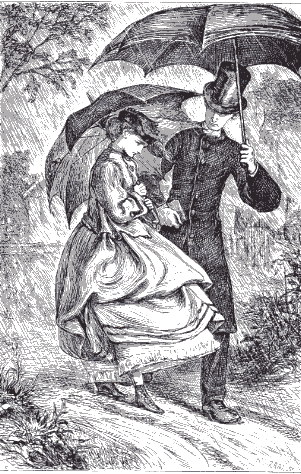
The emphasis is on comedy and caricature. Mr Saul has no three-dimensional depth to him; the arm holding the umbrella is very large; Fanny's dress is whirled about with a sense of wind. A great deal of energy has been expended on getting the win into the picture as well as the details of clothing and umbrellas.
The third picture is in Chapter Seven and is entitled "A Friendly Talk." It shows the conversation between Julia and Harry in Chapter Seven. Both are seated. Julia is leaning on a table looking at Harry. She is dressed in a long flowing black garment and wears a white cap on her head. Harry is stiffly seated in a chair facing the table. He is wearing a suit with a long open coat revealing his vest, and he has a small tie. His right hand is holding his stick, which is pointing at his hat on the floor. The hat is upside down and has something that looks like a handkerchief in it. His left leg is crossed over the right, and his right hand is in his lap. The small finger of the right hand has a ring. Harry's expression is very serious, and Julia's seems to me to be a bit plaintive.
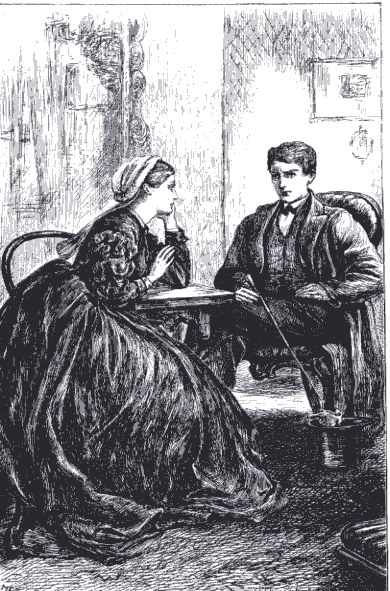
Lady Ongar looks as if she has just finishing crying; her eyes are shadowed; she leans on one elbow on a table, gazing with an earnest appeal into the eyes of the very young man meant to represent Harry Clavering.
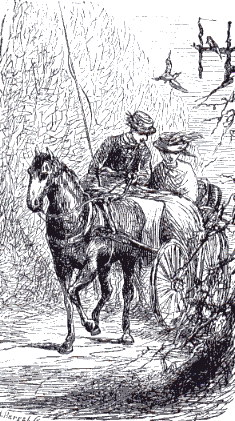
The text is a playful yet serious dialogue between the two lovers. Harry is all interest as he looks down at the shy girl who is swathed in blankets; she wears a hat with feathers which has seen better days. There are birds flying over them as they ride along (a Millais motive in Framley Parsonage). The background is lightly-etched picturesque.
David Christie wrote of Alexy Pendle's illustration: Florence is welcomed at the rectory and to my mind she is very far from a little brown mouse as her large eyes hold the promise of considerable intelligence and self possession. Anyway as my mother-in-law used to tell my wife "it is the quiet ones you have to watch !).
The fourth picture in in Chapter Twelve ('Lady Ongar Takes Possession'). Julia is now examining her property, and the caption is, "Was not the Price in her Hand?" The picture is of Julia in her usual black, including this time her hat. Her left hand extends from her widow's weeds, and the hand mentioned in the caption is covered by a black glove. Her face is in profile, and the one eye visible is opened wide as if she were looking over the farm, which she is doing. The background is full and interesting. A thatched building is to the right with a man sitting on a bench by it. Could that be Mr. Button? A young woman is kneeling at his feet. She looks younger than I think Mrs. Button was, but Mrs. Button is the only farm lady mentioned in the text. Mr. Button has a knife in his left hand and what looks like a piece of fruit in his right hand. Julia is standing by a rustic fence with some lumber lying against it. To the extreme left a wheel and part of a farm building appear. In the far left top there is a building that might be the manor house. A number of birds are circling that house.
To convey the poignancy of the text, Edwards tried for high dark drama in the picture of the rich luxurious lady holdings some coins in an outstretched hand; Mr Button is very old, looks bare and pathetic as does the child. Here is the worldly woman who has sold all in order to be admired by the world. And she finds herself a pariah with farm workers who are realistically desperate.

This is a finely drawn picture
of a statuesque woman in a luxuriously man-folded dress, absorbed by her
letter. The window is left white to suggest the air outside; we see the
fragments of twigs from a bush through it. A heroine in reverie with
depth perspective and a sense of psychological presence the other
vignettes lacked. The problem is we have no sense how troubling
this letter is: it's from Pateroff who is trying to gain entrance
to the house where the 'unprotected' woman lives.
The fifth picture is in Chapter Fourteen ('Count Pateroff and His Sister') and shows Harry and Count Pateroff at the Beaufort Club. The caption is "Did he not bear false witness against her?" Both men are seated at the corner of a dining table which is covered by a cloth which reaches about to the floor. Count Pateroff (son of a father?) is full faced on the right, and Harry is in profile on the left. Both are dressed in formal go-to-the-club clothing. Harry is on the edge of his chair with his left hand extended and his right hand resting on the arm of his chair. Count Pateroff has his right hand on the table and his left hand on his hip or pocket. He is distinguished by a handlebar grey mustache. On the table may be seen behind Harry's extended left arm the tops of several decanters, containing, I think, the certain vintage of Moselle which was very famous at the Beaufort.
Tony Prince wrote as follows (he used the Dover): Trollope wrote: "[Count Pateroff] was a fair man, with a broad face, and very light blue eyes; his forehead was low, but broad; he wore no whiskers, but bore on his lip a heavy moustache which was not grey, but perfectly white - white it was with years of course, but yet it gave no sign of age to his face. He was well made, active, and somewhat broad in the shoulders, though rather below the middle height." (Dover ed., p. 109)
Now judging from the above I would expect him to be quite fit, and visually striking, but in Edwards' disappointing illustration a couple of pages later he appears to be a rather large, chunky fellow with a barber-shop moustache, a small sprouting of hair below his lower lip and a receding hairline. Not at all attractive in my estimation.
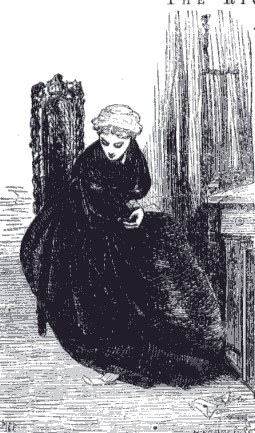
To the side of a figure of a woman on the right there is an indication of a wall by lines down; the chair is ornate but small and narrow, and cross-hatched dark and then light. Here is Julia in her ripped-apart desolation, giving the impression of half or not quite rocking or just about to rock, and yet sitting very still. A good picture is hard to put into words. It's better than poignant, better than downcast, it's suggestive of gripping. The lines that open the chapter are what lead to it: "Lady Ongar sat alone, long into the night..."
This is a moving picture of an older woman. Her face looks downward, and is not filled in with lines, nor her widow's white headpiece. What is genuinely expressive is the outline of the dress. It is a kind of shell. The line from her head curls down past the chair to reach a bottom picture of furniture, and then moves upwards light and then across to reach one white hand which is folded over an elbow. Here is a felt presence. I prefer this to the one of Lady Ongar holding the money in her hand as the former is a moral lesson (see above "Was not the price in her hand?").
The sixth picture is in Chapter Eighteen and is entitled, as is the
chapter, "Captain Clavering makes his First Attempt." Archie is
standing on the left in profile, Julia is in the center in full face, and
Mme. Gourdeloup (fat wolf?) is on the right in profile. Archie has
light-colored trousers and a black coat. His stick is in his left hand
and his top hat in his right. He is standing with his right knee
slightly bent as is his neck. He looks as silly as he is. Julia is
dressed in black with a white cap. Her right elbow is bent with her
hand under her chin as if she were pondering the situation. Her left
hand supports her right elbow. Her expression is bland. Mme.
Gourdeloup is dressed in street clothes, having just arrived. Her hands
are extended slightly beyond her mantle. She is shorter than either of
the others, but she does not look as old as I imagined her. None of the
three shows any expression of pleasure, displeasure, or whatever.
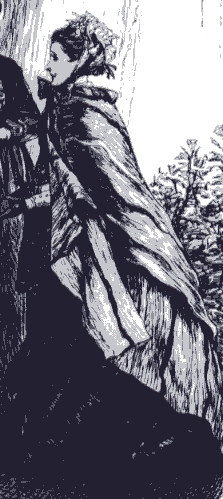
I add that Madame Gordeloup is drawn with a body of wizened sharpness, and acuteness. She has a curious daintiness in the way the body is held; her face is arch and alert, like a bird. The dress too billows out just so, and the pulled in carefully. This fits her. I reprint only the depiction of Sophie from this illustration:
In Chapter 20 ('Desolation') there is a picture labeled, "The Lord giveth, and the Lord taketh away." Lady Clavering here is attempting to comfort her husband, Sir High, after the death of their only child. Sir Hugh is seated in a chair with his arms folded and his eyes straight down. He has mutton chop whiskers and a large mustache. He is dressed in a frock coat with lighter-colored trousers and a strip going down the side of his pantleg. Lady Clavering is dressed in the full gown of the period. She is leaning over his head with her right hand on his arm. She wears no cap, and her hair is light-colored and put into a bun at the rear. A handkerchief appears to be on the floor.

The artist made Hugh too theatrical, with his arms folded like those of a child, the face too grumpy. The figure of the woman who represents Hermione is well done. Underneath the full dress there are shoulders, there is a back, we feel her legs. Her body is anatomically right. She has dignity; the face is sad and appealing; she holds herself in a still solemn dignified way with her hair thick yet held back in its rich bun; the line given the shape of the figure as a whole expresses something like desolation; the woman's arm on the man's is also tense. Perhaps the artist is not thinking of our vulnerable clinging Hermione. The background is expertly cross-hatched. There is depth and dimension to this picture. It's not allegorical, not emblematic, refers to no set of symbols, Christian or otherwise. Two people try quietly to deal with death and fail to comfort one another. There's nothing maudlin here: not even a coffin. It's not stagey.

The figures though are not tightly bunched together, but instead have little spaces between, suggesting a slow walk. The grave is indicated by a tipped to the side cross filled in with cross-hatching; it is tottering slightly in a freshly dug mound beneath. The tree which acts as a frame for the picture forms a kind of arch, slightly gothic at top, so we look at the people as in a church window, the cross on the horizontal width at its bottom. The tree may be said to droop over the two sides of the picture as it arches up to the top. The falling line of the branches on the left side are right, so too the dispersed branches reaching up to the top of the picture on the right. The leaves have that pretty wispy quality; there is another suggestion of a cross in them towards the right top corner of the picture. This is another superb vignette.
The second picture in this week's instalment, '"Harry', she said, 'There is nothing wrong between you and Florence?'", is in Chapter 22 ('The Day of the Funeral'). The speaker is Fanny, and she is speaking to Harry. Fanny is comfortably reclining in a chair. She wears a full white gown, and there is some knitting or something like that in her lap. Her fingers together, and she is turning her face to her right to look at Harry, who is standing at the left of the picture. His left leg is bent around his right, and his left shoe is raised from the floor so that only the toe touches. His hands are in his side pockets. His face is in profile, and again we can tell nothing of it. A window is between them. The text tells us that Fanny is concerned and that Harry is trying to be nonchalant. Fanny's concern does not appear in the picture. She could be asking about the price of eggs. Hary's feigned nonchalance appears only in the position of his legs and hands.
Volume Two of the 1867 first edition of The Claverings begins with a frontispiece which shows Julia Ongar sitting on a rock by the sea and Count Pateroff standing behind her. The caption is, "Lady Ongar, are you not rather near the edge?" The scene appears in Chapter 27 (Chapter 3 in my Volume Two). Julia is visiting the Isle of Wight accompanied only by the devoted Sophie Gordeloup. Count Pateroff has discovered where she has been hiding and has followed her, again with the intention of asking for her hand (and money). She has gone down to the seaside to think over her situation, and Count Pateroff has trailed her there. The picture shows her dressed in a black cloak which hides all of her except her left arm and her face. She is wearing a sort of wedge-shaped hat. Count Pateroff is standing. He is dressed in a frock coat and tall silk hat. His right hand hangs by his side, and his left hand is tucked between two of his coat buttons. He is looking down on her so that his hat covers his eyes, leaving only his nose and mustache visible. Birds and a tiny sail may be seen in the background. She is very close to the edge with sea under her and behind her:

This is a striking picture. Perhaps the characters are made too elegant. Lady Ongar's hat makes a neat triangle over her head; it is echoed in her triangular face (a shape which we saw in the first large illustration of the wedding and the rubric of Harry taking Florence in the cart to the rectory); the triangular face is reversed in the dark cape which flows down from Lady Ongar's neck in an upside down through whose frame we shee Lady Ongar's clearly expensive blouse (lots of folds) and richly depicted skirt. This concern with triangle we find in Count Pateroff: his mustache, the disposition of his jacket over his shirt, his left hand tucked into said jacket, and the left arm, too short (the perspective is wrong) gets nowhere near Lady Ongar. His top hat is very fancy.
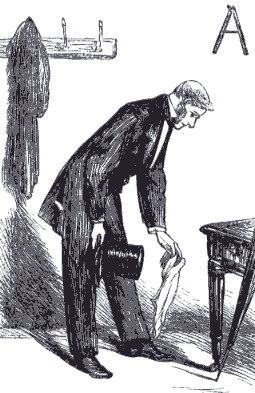
The comedy is good. The man is stiff to the waist and gingerly applies a white clothe to a shoe which is slightly too far away for him to reach unless he were to bend more. He seems awkward, unwilling to bend. He holds a top hat with the other hand. He has an intent expresssion as he stars at the boot. To the right is his coat on a rack. He's a careful sort. It's funny.
The second picture is in the chapter "How Damon Parted from Pythias." A
very angry looking Sophie is seated and glaring at Julia, whose back is
to us. Sophie's face is what I as a child always called a hatchet face.
It is in profile and shows a sharp nose and a turned-down mouth. Her
right arm is on the arm of the chair as if she were about to rise. Julia
is dressed in black, and over her shoulder one can see the candle that
she has taken to light her way to bed. There is no sign in the picture
of the table with the twenty-pound note on it.
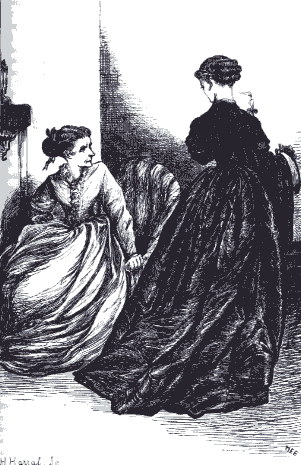
The twisted misery on the face of the desperate Sophie is well done
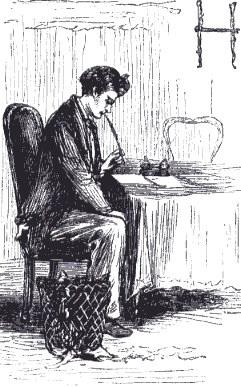
Harry looks weary. He holds his quill above the paper and chews on its end. His brow is furrowed. His face which we see from the side looks tense. His hair looks uncombed. He is not a happy person. The wastepaper basket by his side is a nice touch.
In Chapter Thirty Two ('Florence Burton Packs Up a Packet'), we see a picture of Florence Burton packing up her packet. She is seated forlornly in a chair with her arms crossed over what may be a book or letter. She is gazing sadly at the floor, and we see her face in profile. Her dress is white a flowing, and the chair is one of those where the arms begin a complete circle but stop short in order for the chair to be sat in. There's a name for this kind of chair, but I forget it. To her right is an open box with a handle pictured on one side. It contains what are apparently letters, and some more letters are crumpled on the floor.

The young woman looks just like Celia Johnson (the British Actress who always played virtuous but passionate heroines, e.g, in Brief Encounter with Trevor Howard)! The type has existed for over a century; she was very popular in World War Two movies (she played Noel Coward's wife in In Which We Serve. Hall says Florence has 'an attractive face', and 'well-drawn figure, with strength in her neck and shoulders'.
The second picture in this week's instalment appears in Chapter Thirty Five ('Parting'). Hugh, who will shortly leave on his voyage with Archie and Jack Stuart, is saying goodby to Hermione before going to bed. The text reads, "'Good-by, Hermy,' he said, submitting himself, with the candle in his hand, to the inevitable embrace." Hermione in white is embracing Hugh, who has a candle in his visible hand. the candle is in a holder. He is dressed in black and is looking at her through the embrace. His clothes are black. A newspaper lies on the floor, and a couple of chairs are dimly visible in the dark background.
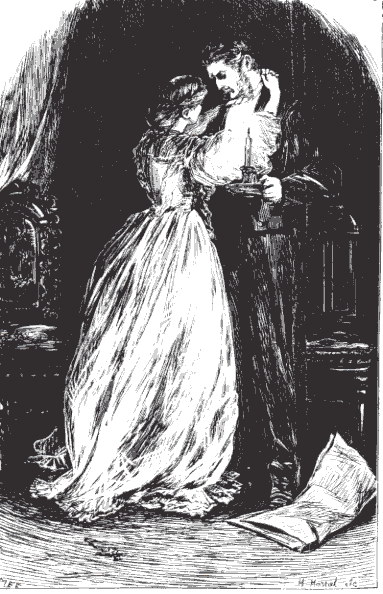
This is one of the best of the original illustrations of Trollope's novels. It deserves to be better known. I discuss and reprint it in my Trollope on the Net. Here I'll say I find a poignant dignity given Hermione once again (as when she attempted to comfort Hugh at the time of their boy's death). Her arm surround Sir Hugh's neck in just the position Trollope describes. We have the candle, the fallen newspaper, two expensive-looking chairs. She looks into his eyes and demands he look down. He does not resist, but while he bows his head slightly, yhere is a strained irritated expression in his face. The two are in a space made by filled-in darkness. Her hair is rich but tamed into a bun at the nape of her neck. Her dress flows like water, like tears.
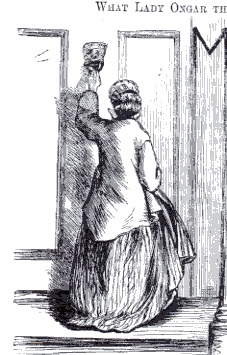
Another superb small picture. It is expressive of a single mood or emotion and the sharp outline of the figure is essential to that expressiveness. The success may come from our not seeing the face. Before this large imposing door Mrs Cecilia Burton seen from the back seems small as she stands on the threshold. One thinks of how hard it still is for the relatively powerless and lower-on-the-particular-totem-pole person to cross thresholds especially when some "boss" or the professor or some authority figure is on the other side. The knocker is slightly too high up. Her arm reaches up and the tips of her fingers seem just barely to knock at it. She holds her dress slightly higher on one side than the other with her other hand. She seems to hesitate slightly. Her hair is in a bun or double-bun sort of affair. She has a plain jacket on, slightly wrinkling over from the back. Here is Cecilia braving the world for Florence. The line that is good is the one that shapes the dress and figure. It is a kind of upside-down-pear once again; it seems to slightly bow out, go down, sweep underneath and then up again straight.
The illustration for Chapter Thirty-Seven or Vol. II Ch. XIII ('What Lady Ongar Thought About It') is entitled "A Plea for Mercy." It shows the conversation between Cecilia Burton and Lady Ongar, in which Cecilia is asking Julia to take her claws out of Harry. In the picture Cecilia has just risen from her chair and is facing a seated Julia. Cecilia has a black cloak over her dress, which is drawn with vertical parallel lines for shading. She wears a small headpiece attached under her chin. Her right hand is open and facing Julia in an attitude of supplication. Julia is dressed in white with a chain over her breast and another higher up holding a locket. Her hands are folded, but one can see bracelets on both wrists. Her face is expressionless, but her eyes are wide opened and fixed on Cecilia. A table with a vase is behind Julia, a picture is on the wall, and part of the chair from which Cecilia just rose is visible.
Lady Ongar looks up half-afraid of Cecilia. In Trollope's text she attempt to intimidate Cecilia; here she looks regretful and half- ashamed. Cecilia Burton and outfit are lovingly drawn.
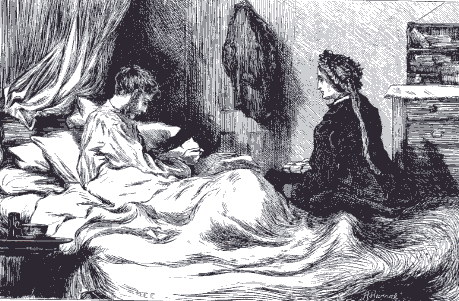
The second picture in this week's instalment is given the caption of the chapter title ('The Sheep Returns to the Fold'). Harry is in bed, and his mother has just entered the room with the parcel. Harry is very unshaven. He wears a white nightdress, and the bedding is also white. His hair is disheveled. Mrs. Clavering is dressed all in black and is wearing a hat. She holds the parcel in her hand. The remains of Harry's breakfast are on a table by the bed. Harry, who leads a hard life, has just had breakfast in bed.
I would compare this one to Marcus Stone's 'Only the Vagaries of an Old Woman' for He Knew He Was Right (see below Annotated Commentary 5 and my Trollope on the Net, Chapter Three. It is not quite as successful because Harry is made to shy away; the intensity of expressive longing on Dorothy's face and the hesitant anxiety and regret on Aunt Stanbury's face is replace by a mother who feels confident of herself. However, the depiction of the bedroom, sudden waking, reverie disturbed and disquiet through the lean drawn face of Harry and the shadows surrounding him is effective.
In this full-page illustration, we see Harry sitting with Florence and Cecilia. The caption is "Harry Sat Between Them Like A Sheep As He Was, Very Meekly." Cecilia and Florence are indistinguishable. One is dressed in white and the other in black. Cecila (I think it is she) carries a peacock fan and is looking down. Florence, in black, is looking at Harry. Harry himself looks like a 1920s matinee idol. That is, he has vapid good looks.
See my long quotation of Margaret Oliphant's disdainful response to the sheep Harry who ricochets between all these women, and her refusal to believe these women would value, much less Florence freely forgive him. Perhaps we are supposed to see the uncomfortable weakness and passivity of the young man. Cecilia does look quietly sexy, like the cat who swallowed the canarie. On the other hand, Florence is once again given dignity and intelligence. Her expression is one of controlled expressionlessness. See my quotation of Robert Polhemus's cynical assessment of her vicarious motives in his The Changing World of Anthony Trollope in my Trollope on the Net, Chapter Five.
The last illustration of the novel (in Chapter Forty Seven, 'Shewing How Things Settled Themselves at the Rectory') shows Julia surrendering to Florence. The caption is "Lady Ongar and Florence." They are out of doors with bushes or trees for a background. Julia is all in black, and Florence has a decorated coat on over her white dress. Julia is semi-hugging Florence. Julia's face is in profile, and her nose is almost at Florence's right eyebrow. Florence is expressionless; her eyes seem to be half closed:
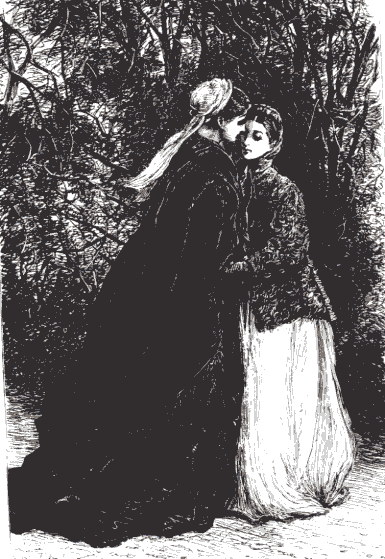
This is another of the finer illustrations among the earliest to Trollope's novels. Edwards illustration brings us back to her first vignette as the two women stand against a thicket of bare brambles which take up three-quarters of the picture space. The swirls of the branches are repeated in the designs of Florence's jacket. Julia towers over Florence, and is draped in black. The mood of the picture is chill and quiet (pp. 502-7). One should compare this with Habl˘t Browne's depiction of 'Priory Ruins' for Can You Forgive Her? (see Annotated Commentary 2). What is most revealing is Trollope choose just these same scenes and they are similarly depicted.